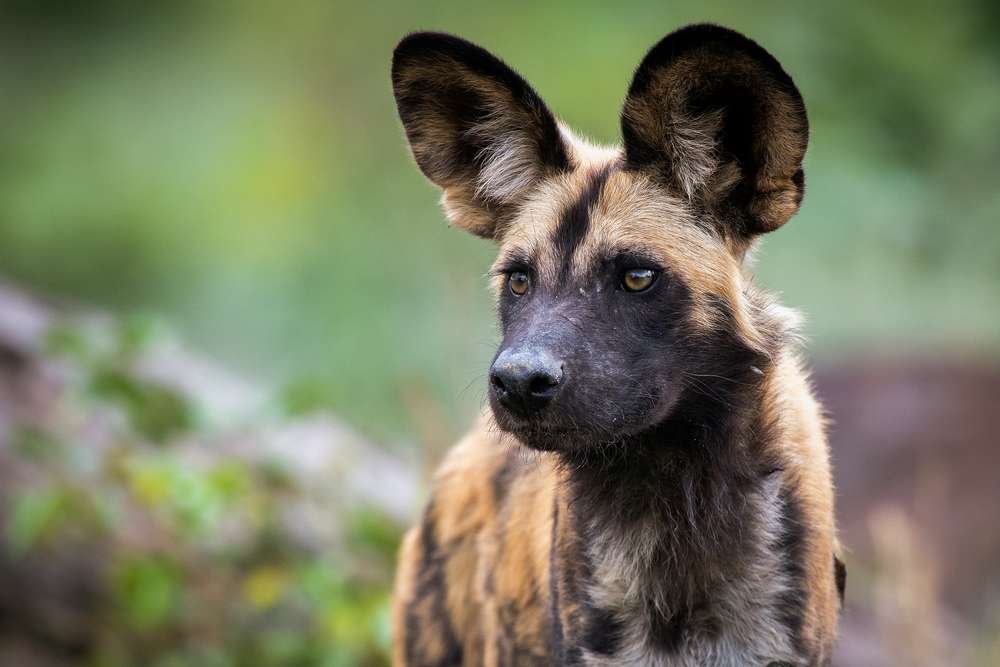African Wild Dog
( mumbulu, umpe, llakanyani, painted dog or Cape hunting dog )
- Lycaon pictus
- IUCN Status: Endangered
- Trend: decreasing

- Kingdom: Animalia
- Phylum: Chordata
- Class: Mammalia
- Order: Carnivora
- Family: Canidae
- Subfamily: Caninae
- Genus: Lycaon
Share:
General Information
Wild dogs are the largest wild canine in Africa. They are the best hunters in the carnivorous class with over 80% success rates. They have a keen sense of hearing, smell and sight and they have an extremely powerful bite, with specialized molars that can shear meat and breaks bones. Best places to see them in the wild are in the Kafue and South Luangwa National Parks. Their natural predators are other large carnivores. Spotted hyena will often try to steal their food. Lions will kill wild dogs and their pups when they meet and will also try and steal their food rather than hunt for their own.
Fun Facts!
Zambia has a large population of wild dogs, and they can be found in all of the country’s national parks.
Zambian wild dogs are particularly common in the South Luangwa National Park, which is home to one of the largest populations of wild dogs in Africa.
Zambian wild dogs play an important role in the ecosystem by helping to control populations of prey animals. Yes, wild dogs have a matriarchal society. This means that the females are dominant over the males. The alpha female is the largest and strongest wild dog in the pack, and she leads the hunts and makes all the important decisions.
The alpha female is also responsible for breeding. She will only breed with the alpha male, and the rest of the females in the pack will not breed. This is because the alpha female wants to ensure that her offspring are the strongest and healthiest.
Wild dog packs are very cooperative, and all of the members of the pack work together to raise the young. The alpha female will nurse her pups, but she will also allow the other females in the pack to nurse her pups as well. The males will also help to care for the pups, and they will often regurgitate food for the pups to eat.
Description
- Shoulder height: 75 cm
- Length: 85 – 140 cm
- Weight: 18 – 34 kg
- Lifespan: 10 to 12 years
Ecology and Behaviour
Wild dogs are very social, living in mixed packs of around 10 or more closely related individuals. They have a strict hierarchy, with an alpha breeding pair dominating over the rest of their pack. When one of their subordinates becomes injured or ill the rest of the pack feeds and cares for them. New packs are formed when a mature female leaves her pack to find a new mate. This is thought to guard against in-breeding. They all eat, play, hunt and even sleep together
Using teamwork to hunt, the pack fans out to cover more ground, giving chase to their selected prey. Like a relay-team, as the leaders tire out other member of their pack continues to give chase, eventually exhausting their prey. This coordinated strategy means that they have a high hunting success rate and they can take down antelope much larger than themselves. To avoid their food from being stolen by other carnivores they eat extremely quickly. They hunt impala, wildebeest zebra and kudu in the cooler mornings and evenings. They also eat hares, lizards and eggs.
Wild dogs will bark an alarm call, growl to express anger and will let out a low-pitched cooing sound when they greet one another. When hunting and feeding they make bird-like ‘twittering’ sounds. To attract attention youngsters make a variety of whines. They are very tactile and rarely fight one another. They use scent to communicate and they have a strong body odour which is thought to help them identify individuals at night and when hunting.
Conservation
African wild dogs are classified as Endangered on the IUCN Red List. Wild dog populations have declined dramatically in recent decades due to habitat loss, poaching, and disease. Zambia is one of the few countries where wild dogs are still relatively common
Distribution and Habitat
Only the alpha female gives birth to between four and up to twelve pups. They are born in dens and will remain hidden for up to three months. A new mother will stay with her pups with other pack members bringing her food. All members co-operative care for the pups, helping to feed and ‘baby-sit’ them until they become adults at almost two years old.
Wild dogs are very nomadic, traveling large distances to find food. Their home ranges can be as large as 5,000 sq kms and so they live in a range of habitats including plains, savanna, woodlands and forests.
Interaction with humans
Threats to Wild dogs include, habitat fragmentation, human wildlife conflict and they are susceptible to diseases caught from domestic dogs.
No donation to this project yet.
| M | T | W | T | F | S | S |
|---|---|---|---|---|---|---|
| 1 | 2 | 3 | 4 | 5 | 6 | 7 |
| 8 | 9 | 10 | 11 | 12 | 13 | 14 |
| 15 | 16 | 17 | 18 | 19 | 20 | 21 |
| 22 | 23 | 24 | 25 | 26 | 27 | 28 |
| 29 | 30 | 31 | ||||


